Hospitality Business Strategy: Fairmont Hotels and Resorts
VerifiedAdded on 2023/01/11
|14
|3654
|80
AI Summary
This project analyzes the impact of macro environmental factors on the operations of the hospitality industry using PESTLE analysis. It also examines the internal environment using SWOT analysis and VRIO model. Additionally, it demonstrates Porter's Five Force model for developing competitive strategies in strategic management planning.
Contribute Materials
Your contribution can guide someone’s learning journey. Share your
documents today.
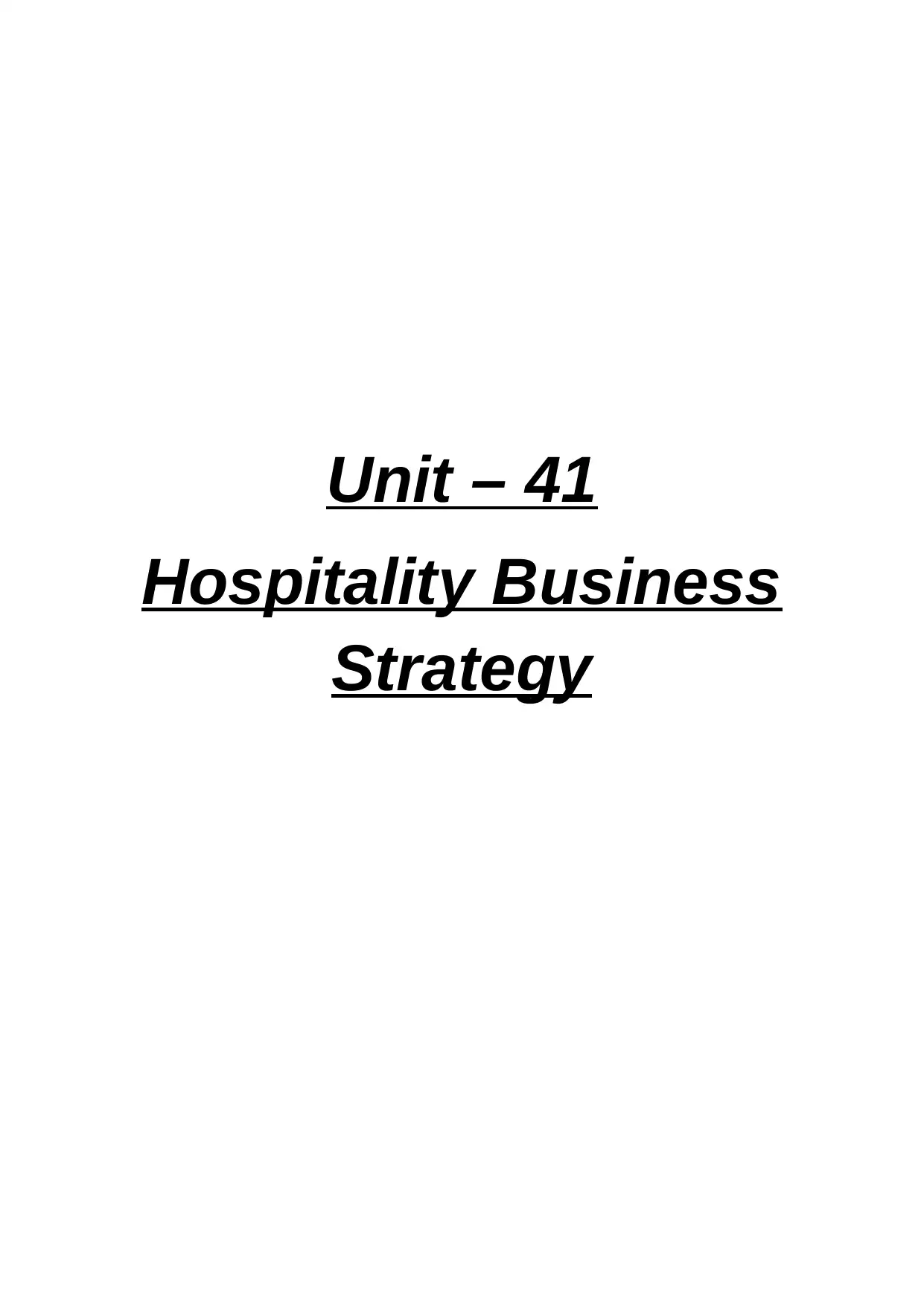
Unit – 41
Hospitality Business
Strategy
Hospitality Business
Strategy
Secure Best Marks with AI Grader
Need help grading? Try our AI Grader for instant feedback on your assignments.
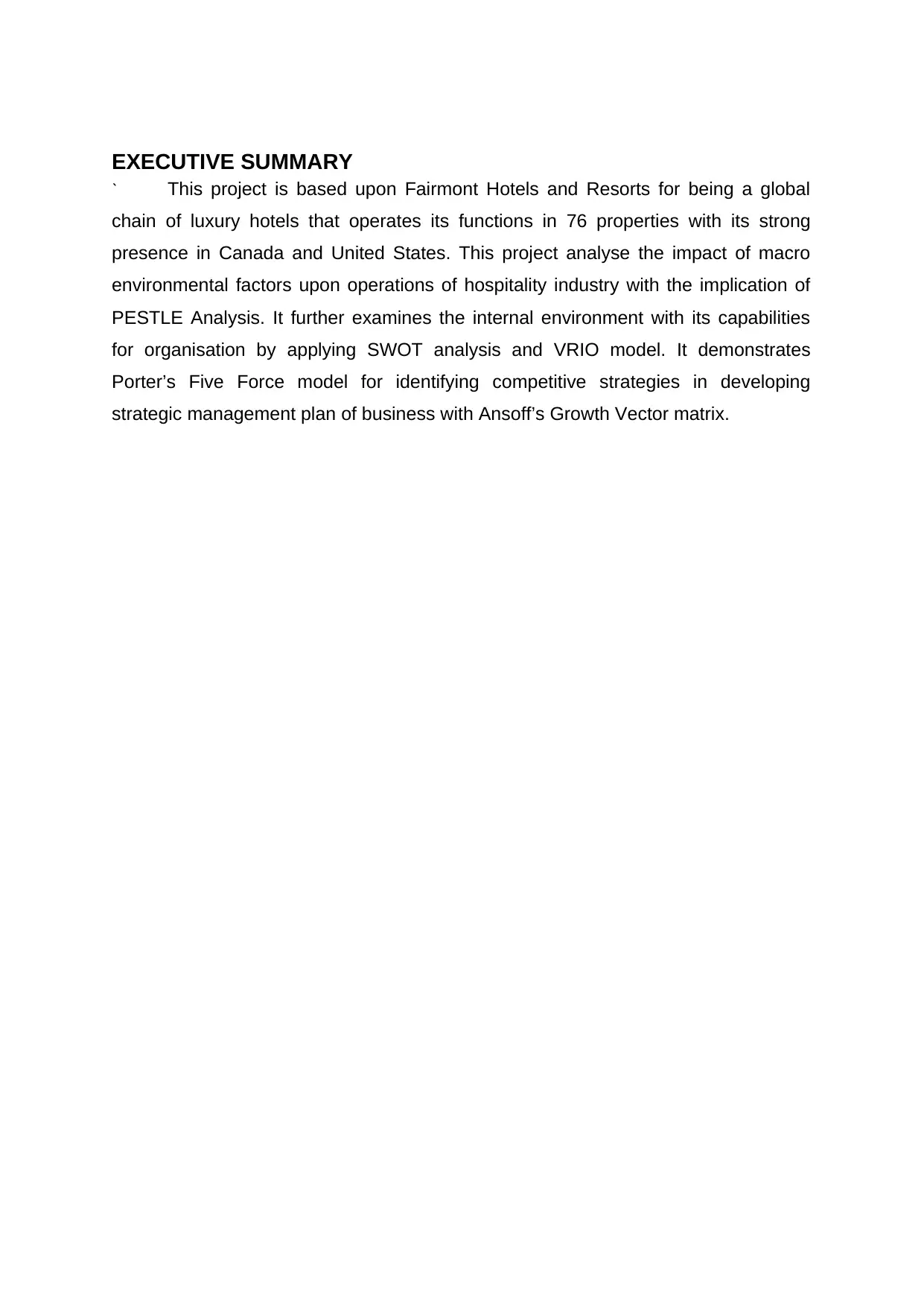
EXECUTIVE SUMMARY
` This project is based upon Fairmont Hotels and Resorts for being a global
chain of luxury hotels that operates its functions in 76 properties with its strong
presence in Canada and United States. This project analyse the impact of macro
environmental factors upon operations of hospitality industry with the implication of
PESTLE Analysis. It further examines the internal environment with its capabilities
for organisation by applying SWOT analysis and VRIO model. It demonstrates
Porter’s Five Force model for identifying competitive strategies in developing
strategic management plan of business with Ansoff’s Growth Vector matrix.
` This project is based upon Fairmont Hotels and Resorts for being a global
chain of luxury hotels that operates its functions in 76 properties with its strong
presence in Canada and United States. This project analyse the impact of macro
environmental factors upon operations of hospitality industry with the implication of
PESTLE Analysis. It further examines the internal environment with its capabilities
for organisation by applying SWOT analysis and VRIO model. It demonstrates
Porter’s Five Force model for identifying competitive strategies in developing
strategic management plan of business with Ansoff’s Growth Vector matrix.
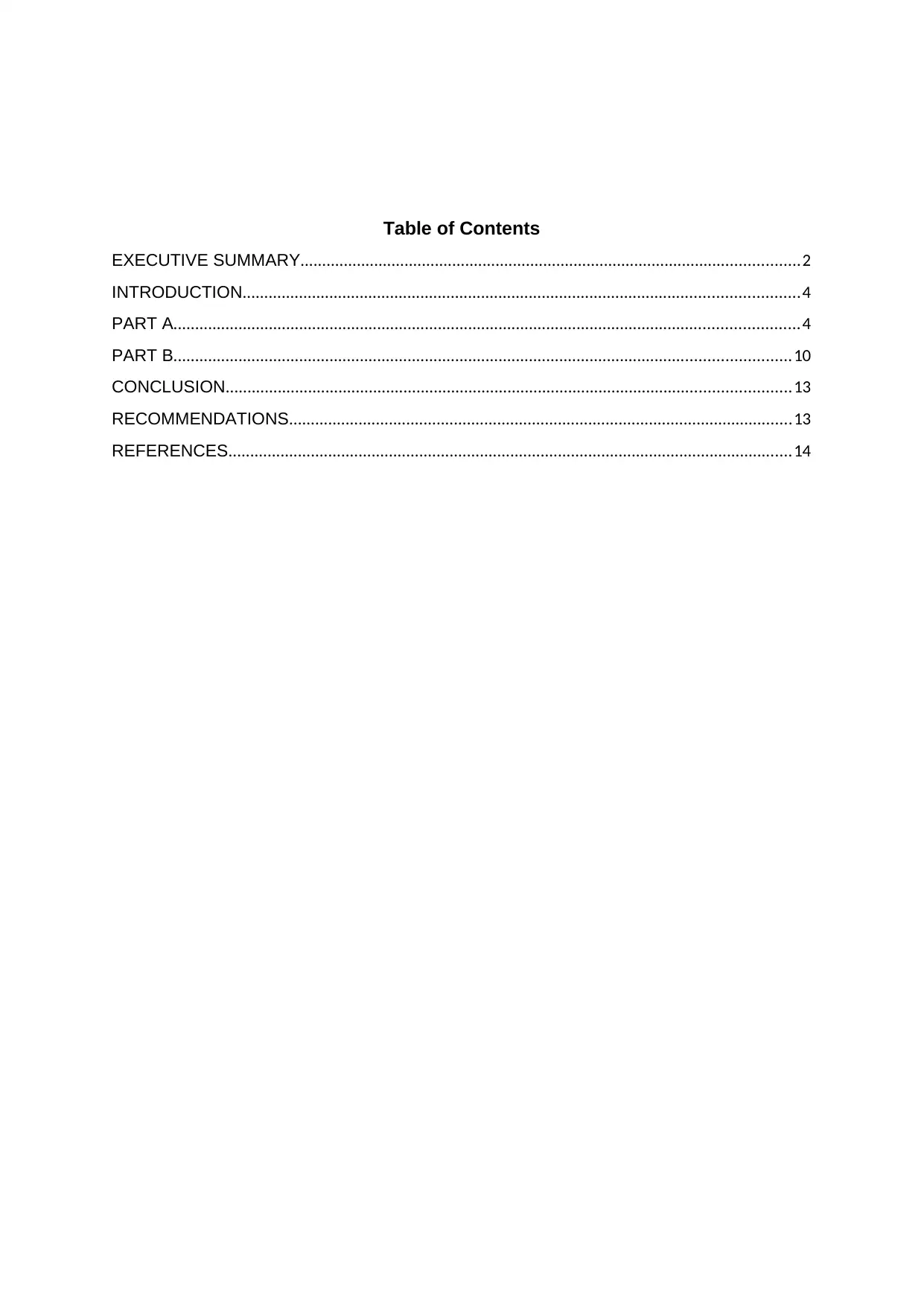
Table of Contents
EXECUTIVE SUMMARY...................................................................................................................2
INTRODUCTION................................................................................................................................4
PART A................................................................................................................................................4
PART B..............................................................................................................................................10
CONCLUSION..................................................................................................................................13
RECOMMENDATIONS....................................................................................................................13
REFERENCES..................................................................................................................................14
EXECUTIVE SUMMARY...................................................................................................................2
INTRODUCTION................................................................................................................................4
PART A................................................................................................................................................4
PART B..............................................................................................................................................10
CONCLUSION..................................................................................................................................13
RECOMMENDATIONS....................................................................................................................13
REFERENCES..................................................................................................................................14
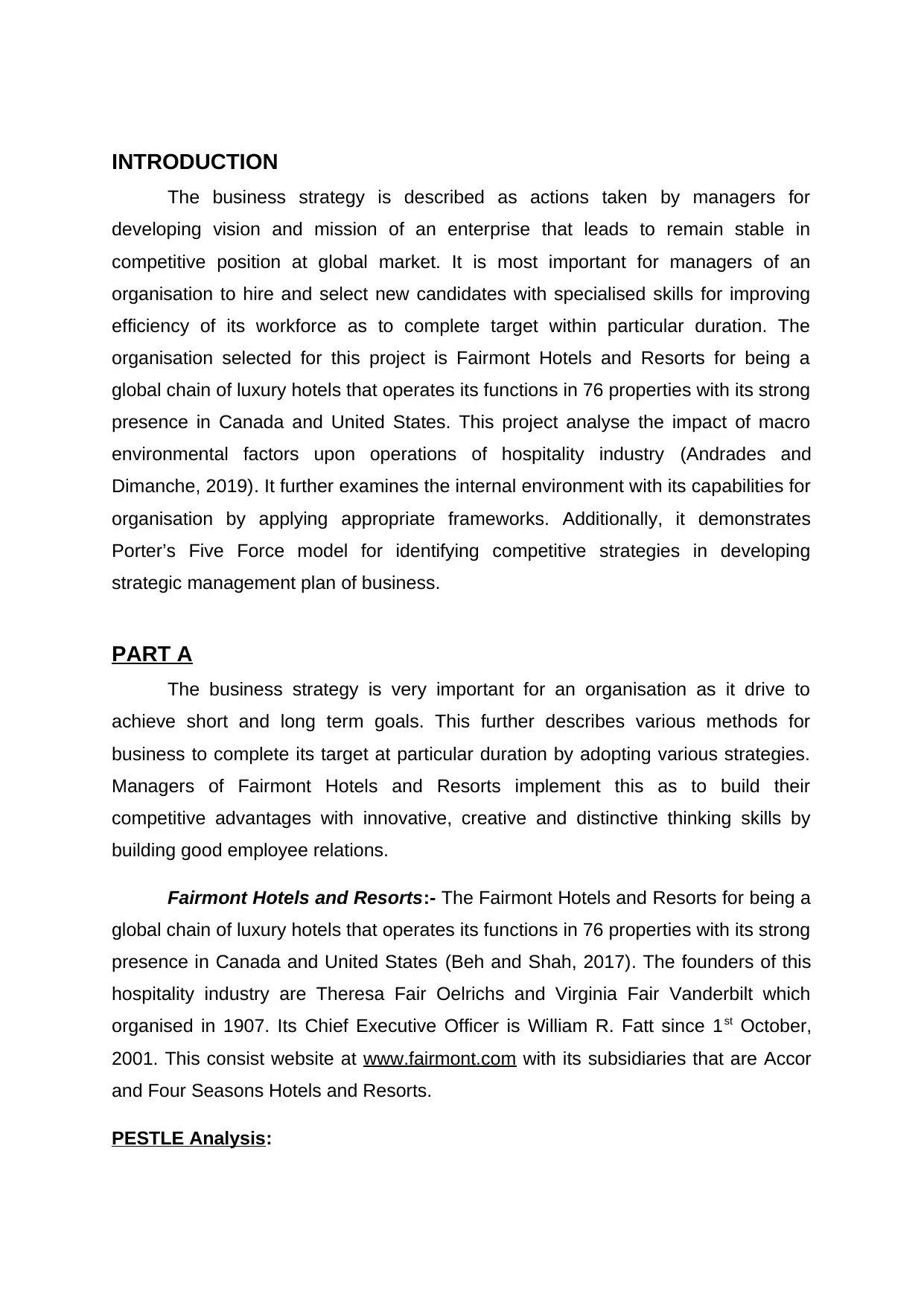
INTRODUCTION
The business strategy is described as actions taken by managers for
developing vision and mission of an enterprise that leads to remain stable in
competitive position at global market. It is most important for managers of an
organisation to hire and select new candidates with specialised skills for improving
efficiency of its workforce as to complete target within particular duration. The
organisation selected for this project is Fairmont Hotels and Resorts for being a
global chain of luxury hotels that operates its functions in 76 properties with its strong
presence in Canada and United States. This project analyse the impact of macro
environmental factors upon operations of hospitality industry (Andrades and
Dimanche, 2019). It further examines the internal environment with its capabilities for
organisation by applying appropriate frameworks. Additionally, it demonstrates
Porter’s Five Force model for identifying competitive strategies in developing
strategic management plan of business.
PART A
The business strategy is very important for an organisation as it drive to
achieve short and long term goals. This further describes various methods for
business to complete its target at particular duration by adopting various strategies.
Managers of Fairmont Hotels and Resorts implement this as to build their
competitive advantages with innovative, creative and distinctive thinking skills by
building good employee relations.
Fairmont Hotels and Resorts:- The Fairmont Hotels and Resorts for being a
global chain of luxury hotels that operates its functions in 76 properties with its strong
presence in Canada and United States (Beh and Shah, 2017). The founders of this
hospitality industry are Theresa Fair Oelrichs and Virginia Fair Vanderbilt which
organised in 1907. Its Chief Executive Officer is William R. Fatt since 1st October,
2001. This consist website at www.fairmont.com with its subsidiaries that are Accor
and Four Seasons Hotels and Resorts.
PESTLE Analysis:
The business strategy is described as actions taken by managers for
developing vision and mission of an enterprise that leads to remain stable in
competitive position at global market. It is most important for managers of an
organisation to hire and select new candidates with specialised skills for improving
efficiency of its workforce as to complete target within particular duration. The
organisation selected for this project is Fairmont Hotels and Resorts for being a
global chain of luxury hotels that operates its functions in 76 properties with its strong
presence in Canada and United States. This project analyse the impact of macro
environmental factors upon operations of hospitality industry (Andrades and
Dimanche, 2019). It further examines the internal environment with its capabilities for
organisation by applying appropriate frameworks. Additionally, it demonstrates
Porter’s Five Force model for identifying competitive strategies in developing
strategic management plan of business.
PART A
The business strategy is very important for an organisation as it drive to
achieve short and long term goals. This further describes various methods for
business to complete its target at particular duration by adopting various strategies.
Managers of Fairmont Hotels and Resorts implement this as to build their
competitive advantages with innovative, creative and distinctive thinking skills by
building good employee relations.
Fairmont Hotels and Resorts:- The Fairmont Hotels and Resorts for being a
global chain of luxury hotels that operates its functions in 76 properties with its strong
presence in Canada and United States (Beh and Shah, 2017). The founders of this
hospitality industry are Theresa Fair Oelrichs and Virginia Fair Vanderbilt which
organised in 1907. Its Chief Executive Officer is William R. Fatt since 1st October,
2001. This consist website at www.fairmont.com with its subsidiaries that are Accor
and Four Seasons Hotels and Resorts.
PESTLE Analysis:
Secure Best Marks with AI Grader
Need help grading? Try our AI Grader for instant feedback on your assignments.
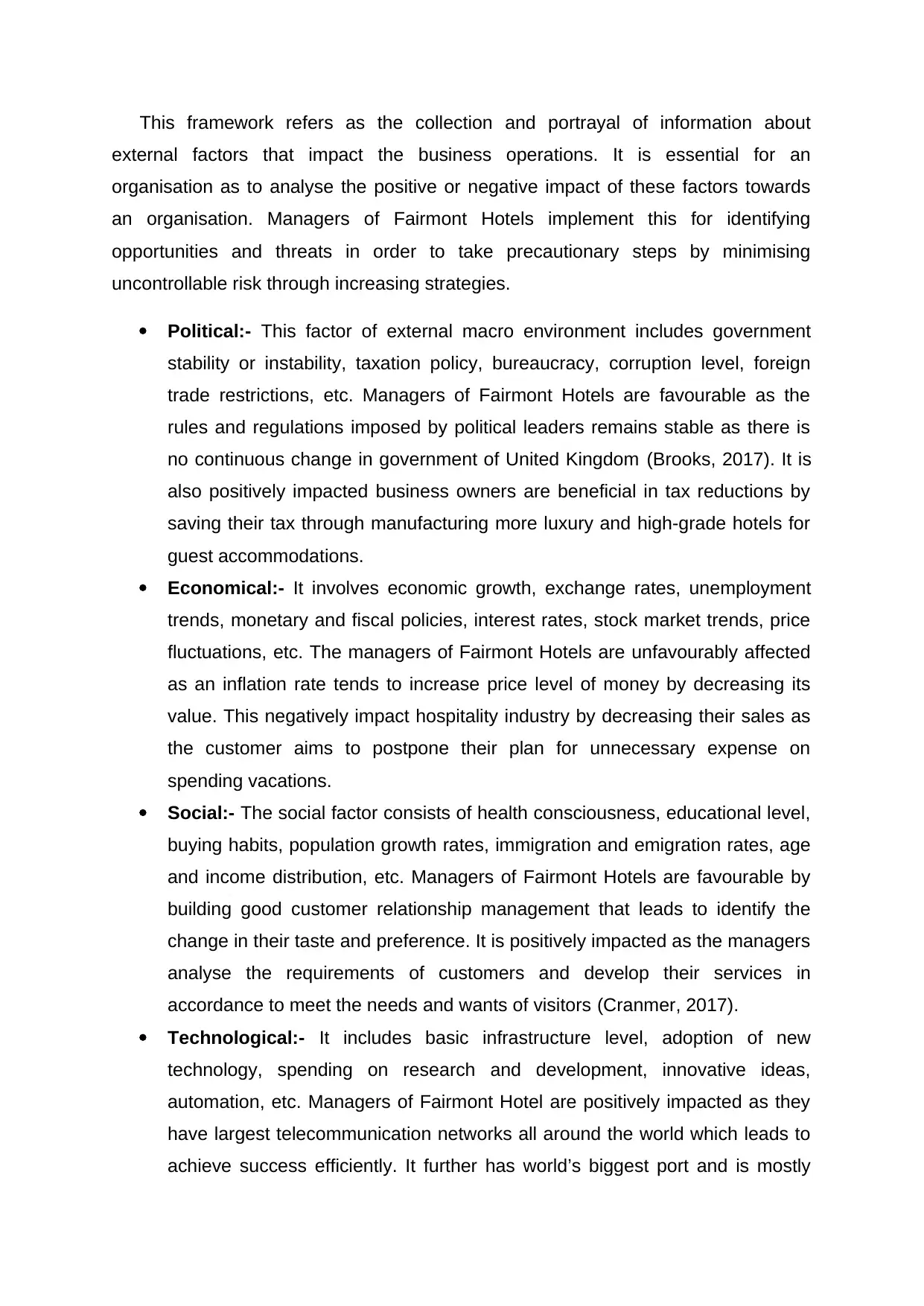
This framework refers as the collection and portrayal of information about
external factors that impact the business operations. It is essential for an
organisation as to analyse the positive or negative impact of these factors towards
an organisation. Managers of Fairmont Hotels implement this for identifying
opportunities and threats in order to take precautionary steps by minimising
uncontrollable risk through increasing strategies.
Political:- This factor of external macro environment includes government
stability or instability, taxation policy, bureaucracy, corruption level, foreign
trade restrictions, etc. Managers of Fairmont Hotels are favourable as the
rules and regulations imposed by political leaders remains stable as there is
no continuous change in government of United Kingdom (Brooks, 2017). It is
also positively impacted business owners are beneficial in tax reductions by
saving their tax through manufacturing more luxury and high-grade hotels for
guest accommodations.
Economical:- It involves economic growth, exchange rates, unemployment
trends, monetary and fiscal policies, interest rates, stock market trends, price
fluctuations, etc. The managers of Fairmont Hotels are unfavourably affected
as an inflation rate tends to increase price level of money by decreasing its
value. This negatively impact hospitality industry by decreasing their sales as
the customer aims to postpone their plan for unnecessary expense on
spending vacations.
Social:- The social factor consists of health consciousness, educational level,
buying habits, population growth rates, immigration and emigration rates, age
and income distribution, etc. Managers of Fairmont Hotels are favourable by
building good customer relationship management that leads to identify the
change in their taste and preference. It is positively impacted as the managers
analyse the requirements of customers and develop their services in
accordance to meet the needs and wants of visitors (Cranmer, 2017).
Technological:- It includes basic infrastructure level, adoption of new
technology, spending on research and development, innovative ideas,
automation, etc. Managers of Fairmont Hotel are positively impacted as they
have largest telecommunication networks all around the world which leads to
achieve success efficiently. It further has world’s biggest port and is mostly
external factors that impact the business operations. It is essential for an
organisation as to analyse the positive or negative impact of these factors towards
an organisation. Managers of Fairmont Hotels implement this for identifying
opportunities and threats in order to take precautionary steps by minimising
uncontrollable risk through increasing strategies.
Political:- This factor of external macro environment includes government
stability or instability, taxation policy, bureaucracy, corruption level, foreign
trade restrictions, etc. Managers of Fairmont Hotels are favourable as the
rules and regulations imposed by political leaders remains stable as there is
no continuous change in government of United Kingdom (Brooks, 2017). It is
also positively impacted business owners are beneficial in tax reductions by
saving their tax through manufacturing more luxury and high-grade hotels for
guest accommodations.
Economical:- It involves economic growth, exchange rates, unemployment
trends, monetary and fiscal policies, interest rates, stock market trends, price
fluctuations, etc. The managers of Fairmont Hotels are unfavourably affected
as an inflation rate tends to increase price level of money by decreasing its
value. This negatively impact hospitality industry by decreasing their sales as
the customer aims to postpone their plan for unnecessary expense on
spending vacations.
Social:- The social factor consists of health consciousness, educational level,
buying habits, population growth rates, immigration and emigration rates, age
and income distribution, etc. Managers of Fairmont Hotels are favourable by
building good customer relationship management that leads to identify the
change in their taste and preference. It is positively impacted as the managers
analyse the requirements of customers and develop their services in
accordance to meet the needs and wants of visitors (Cranmer, 2017).
Technological:- It includes basic infrastructure level, adoption of new
technology, spending on research and development, innovative ideas,
automation, etc. Managers of Fairmont Hotel are positively impacted as they
have largest telecommunication networks all around the world which leads to
achieve success efficiently. It further has world’s biggest port and is mostly

considered as logistic center that leads to enlarge customers with its brand
positioning.
Legal:- This factor involves anti-trust laws, consumer protection rights,
employment legislations, health and safety laws, etc. The managers of
Fairmont Hotel are unfavourably affected as they have transparent legal
environment by following legal legislations of government such as truth-in-
menu laws (Griesmayr, 2019).
Environmental:- The environmental factor consists of weather, climate, air
and water pollution, recycling, waste management, endangered species, etc.
Managers of Fairmont Hotel are favourably affected as they already aims to
minimise pollution through planting more and more trees around the business.
It is positively impacted through properly managing its waste disposal by
recycling it into effective manner that leads to reduce cost.
Internal Environment: This is defined as the ability of managers to manage and run
their business through developing employee relations by respecting beliefs, culture,
attitudes and values of one another. Managers of Fairmont Hotels and Resorts focus
on this as to motivate their workforce for giving their high level of efforts towards
business in order to achieve individual and organisational goals.
SWOT Analysis:
It is a strategic planning technique that is executed by managers of an
organisation for analysing their intrinsic strength over weakness (Loureiro and
Sarmento, 2017). It is very useful for organisation as it highlights weakness and
develops an opportunity for managers to reverse this into strength that leads to
increase competitive strategy. Managers of Fairmont Hotel implement this
minimising the controllable risk of business and to develop strength and
opportunities for sustaining in global market.
Strength (S) Weakness (W)
The managers of Fairmont Hotels
and Resorts develop strength by
building its good image and
reputation in front of target market
that leads to increase its sale and
The managers of Fairmont Hotels
and Resorts face weakness as
being oldest hotel which was
situated on 1907, that is 113 years
ago. It requires certain
positioning.
Legal:- This factor involves anti-trust laws, consumer protection rights,
employment legislations, health and safety laws, etc. The managers of
Fairmont Hotel are unfavourably affected as they have transparent legal
environment by following legal legislations of government such as truth-in-
menu laws (Griesmayr, 2019).
Environmental:- The environmental factor consists of weather, climate, air
and water pollution, recycling, waste management, endangered species, etc.
Managers of Fairmont Hotel are favourably affected as they already aims to
minimise pollution through planting more and more trees around the business.
It is positively impacted through properly managing its waste disposal by
recycling it into effective manner that leads to reduce cost.
Internal Environment: This is defined as the ability of managers to manage and run
their business through developing employee relations by respecting beliefs, culture,
attitudes and values of one another. Managers of Fairmont Hotels and Resorts focus
on this as to motivate their workforce for giving their high level of efforts towards
business in order to achieve individual and organisational goals.
SWOT Analysis:
It is a strategic planning technique that is executed by managers of an
organisation for analysing their intrinsic strength over weakness (Loureiro and
Sarmento, 2017). It is very useful for organisation as it highlights weakness and
develops an opportunity for managers to reverse this into strength that leads to
increase competitive strategy. Managers of Fairmont Hotel implement this
minimising the controllable risk of business and to develop strength and
opportunities for sustaining in global market.
Strength (S) Weakness (W)
The managers of Fairmont Hotels
and Resorts develop strength by
building its good image and
reputation in front of target market
that leads to increase its sale and
The managers of Fairmont Hotels
and Resorts face weakness as
being oldest hotel which was
situated on 1907, that is 113 years
ago. It requires certain
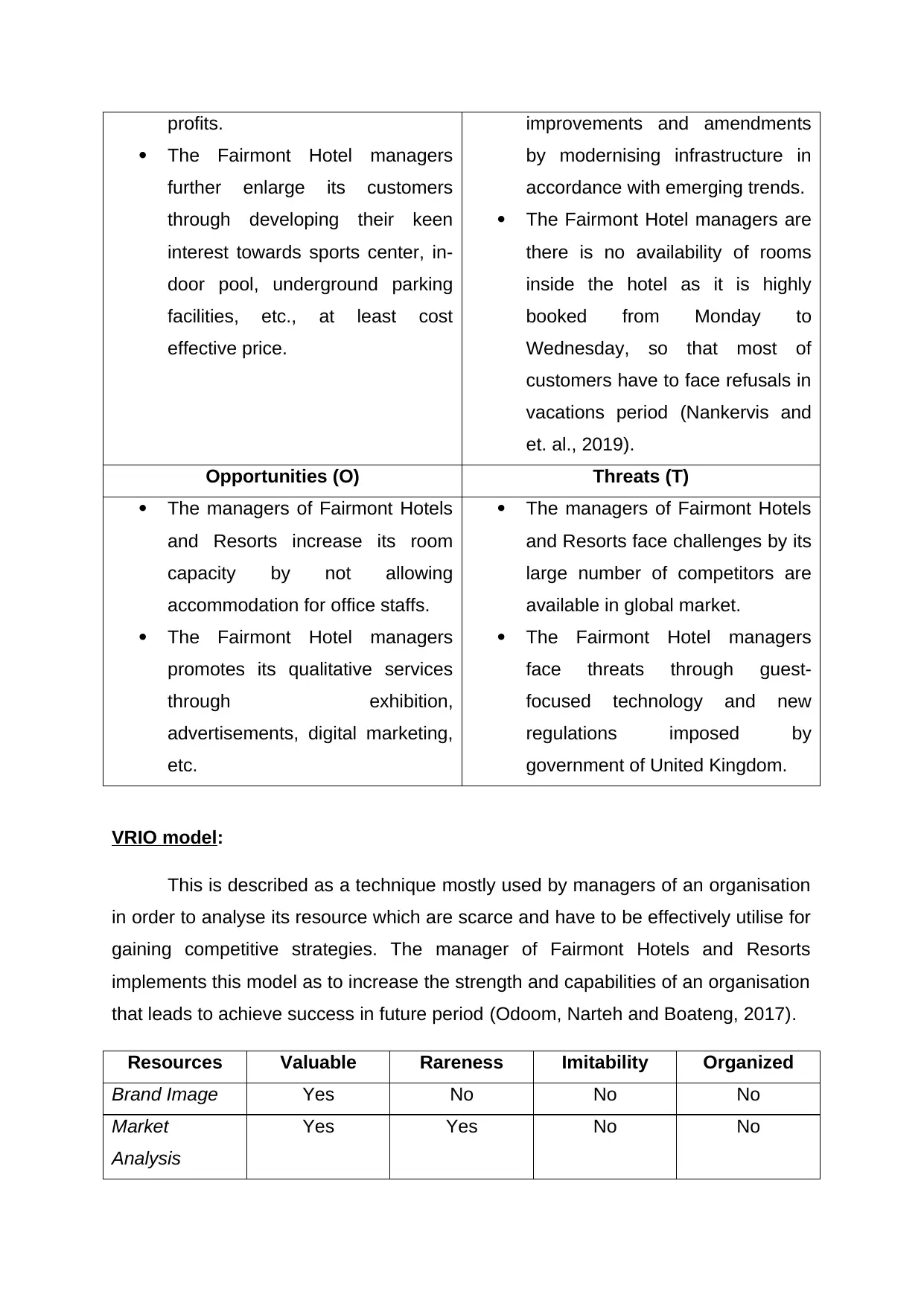
profits.
The Fairmont Hotel managers
further enlarge its customers
through developing their keen
interest towards sports center, in-
door pool, underground parking
facilities, etc., at least cost
effective price.
improvements and amendments
by modernising infrastructure in
accordance with emerging trends.
The Fairmont Hotel managers are
there is no availability of rooms
inside the hotel as it is highly
booked from Monday to
Wednesday, so that most of
customers have to face refusals in
vacations period (Nankervis and
et. al., 2019).
Opportunities (O) Threats (T)
The managers of Fairmont Hotels
and Resorts increase its room
capacity by not allowing
accommodation for office staffs.
The Fairmont Hotel managers
promotes its qualitative services
through exhibition,
advertisements, digital marketing,
etc.
The managers of Fairmont Hotels
and Resorts face challenges by its
large number of competitors are
available in global market.
The Fairmont Hotel managers
face threats through guest-
focused technology and new
regulations imposed by
government of United Kingdom.
VRIO model:
This is described as a technique mostly used by managers of an organisation
in order to analyse its resource which are scarce and have to be effectively utilise for
gaining competitive strategies. The manager of Fairmont Hotels and Resorts
implements this model as to increase the strength and capabilities of an organisation
that leads to achieve success in future period (Odoom, Narteh and Boateng, 2017).
Resources Valuable Rareness Imitability Organized
Brand Image Yes No No No
Market
Analysis
Yes Yes No No
The Fairmont Hotel managers
further enlarge its customers
through developing their keen
interest towards sports center, in-
door pool, underground parking
facilities, etc., at least cost
effective price.
improvements and amendments
by modernising infrastructure in
accordance with emerging trends.
The Fairmont Hotel managers are
there is no availability of rooms
inside the hotel as it is highly
booked from Monday to
Wednesday, so that most of
customers have to face refusals in
vacations period (Nankervis and
et. al., 2019).
Opportunities (O) Threats (T)
The managers of Fairmont Hotels
and Resorts increase its room
capacity by not allowing
accommodation for office staffs.
The Fairmont Hotel managers
promotes its qualitative services
through exhibition,
advertisements, digital marketing,
etc.
The managers of Fairmont Hotels
and Resorts face challenges by its
large number of competitors are
available in global market.
The Fairmont Hotel managers
face threats through guest-
focused technology and new
regulations imposed by
government of United Kingdom.
VRIO model:
This is described as a technique mostly used by managers of an organisation
in order to analyse its resource which are scarce and have to be effectively utilise for
gaining competitive strategies. The manager of Fairmont Hotels and Resorts
implements this model as to increase the strength and capabilities of an organisation
that leads to achieve success in future period (Odoom, Narteh and Boateng, 2017).
Resources Valuable Rareness Imitability Organized
Brand Image Yes No No No
Market
Analysis
Yes Yes No No
Paraphrase This Document
Need a fresh take? Get an instant paraphrase of this document with our AI Paraphraser
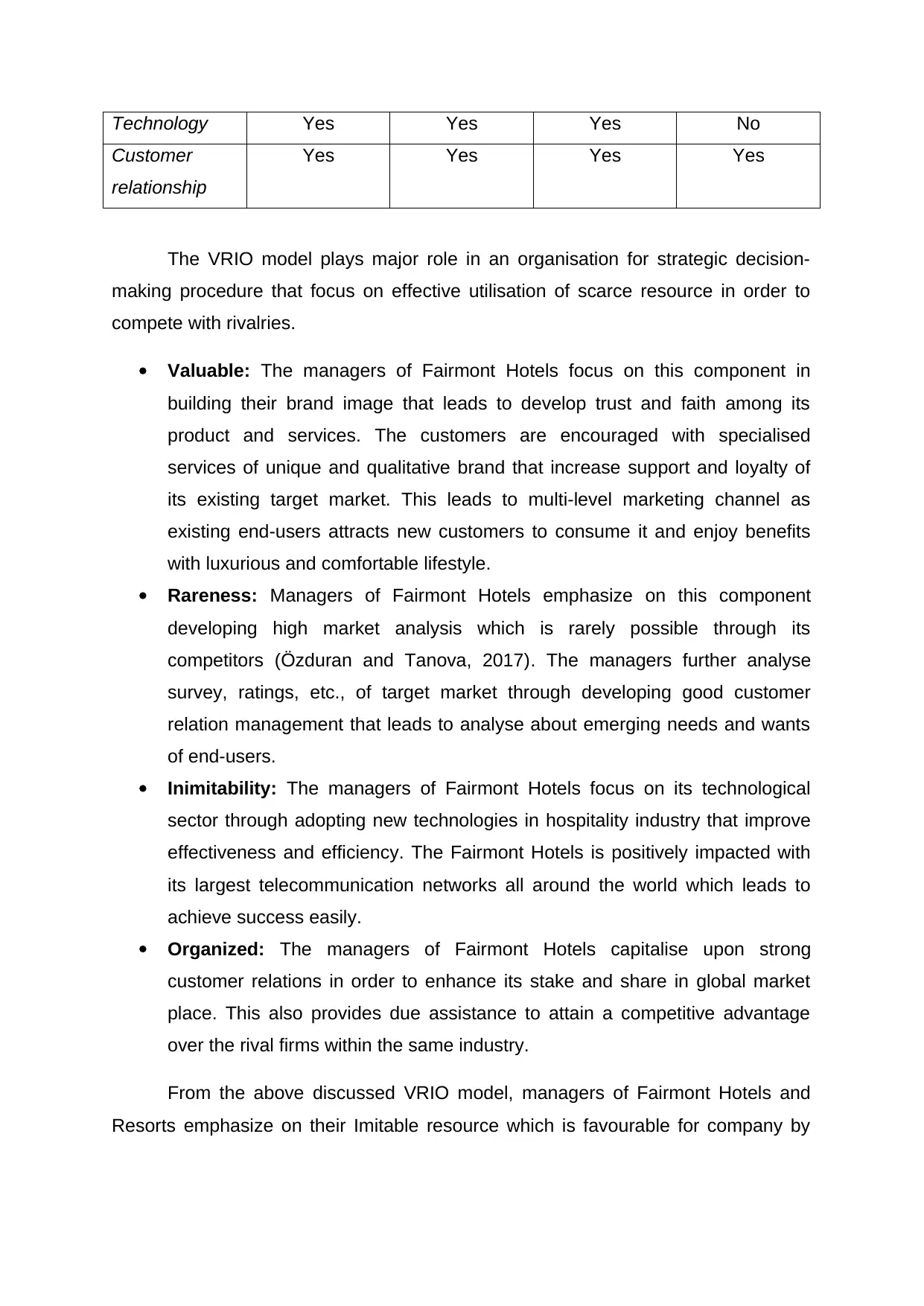
Technology Yes Yes Yes No
Customer
relationship
Yes Yes Yes Yes
The VRIO model plays major role in an organisation for strategic decision-
making procedure that focus on effective utilisation of scarce resource in order to
compete with rivalries.
Valuable: The managers of Fairmont Hotels focus on this component in
building their brand image that leads to develop trust and faith among its
product and services. The customers are encouraged with specialised
services of unique and qualitative brand that increase support and loyalty of
its existing target market. This leads to multi-level marketing channel as
existing end-users attracts new customers to consume it and enjoy benefits
with luxurious and comfortable lifestyle.
Rareness: Managers of Fairmont Hotels emphasize on this component
developing high market analysis which is rarely possible through its
competitors (Özduran and Tanova, 2017). The managers further analyse
survey, ratings, etc., of target market through developing good customer
relation management that leads to analyse about emerging needs and wants
of end-users.
Inimitability: The managers of Fairmont Hotels focus on its technological
sector through adopting new technologies in hospitality industry that improve
effectiveness and efficiency. The Fairmont Hotels is positively impacted with
its largest telecommunication networks all around the world which leads to
achieve success easily.
Organized: The managers of Fairmont Hotels capitalise upon strong
customer relations in order to enhance its stake and share in global market
place. This also provides due assistance to attain a competitive advantage
over the rival firms within the same industry.
From the above discussed VRIO model, managers of Fairmont Hotels and
Resorts emphasize on their Imitable resource which is favourable for company by
Customer
relationship
Yes Yes Yes Yes
The VRIO model plays major role in an organisation for strategic decision-
making procedure that focus on effective utilisation of scarce resource in order to
compete with rivalries.
Valuable: The managers of Fairmont Hotels focus on this component in
building their brand image that leads to develop trust and faith among its
product and services. The customers are encouraged with specialised
services of unique and qualitative brand that increase support and loyalty of
its existing target market. This leads to multi-level marketing channel as
existing end-users attracts new customers to consume it and enjoy benefits
with luxurious and comfortable lifestyle.
Rareness: Managers of Fairmont Hotels emphasize on this component
developing high market analysis which is rarely possible through its
competitors (Özduran and Tanova, 2017). The managers further analyse
survey, ratings, etc., of target market through developing good customer
relation management that leads to analyse about emerging needs and wants
of end-users.
Inimitability: The managers of Fairmont Hotels focus on its technological
sector through adopting new technologies in hospitality industry that improve
effectiveness and efficiency. The Fairmont Hotels is positively impacted with
its largest telecommunication networks all around the world which leads to
achieve success easily.
Organized: The managers of Fairmont Hotels capitalise upon strong
customer relations in order to enhance its stake and share in global market
place. This also provides due assistance to attain a competitive advantage
over the rival firms within the same industry.
From the above discussed VRIO model, managers of Fairmont Hotels and
Resorts emphasize on their Imitable resource which is favourable for company by
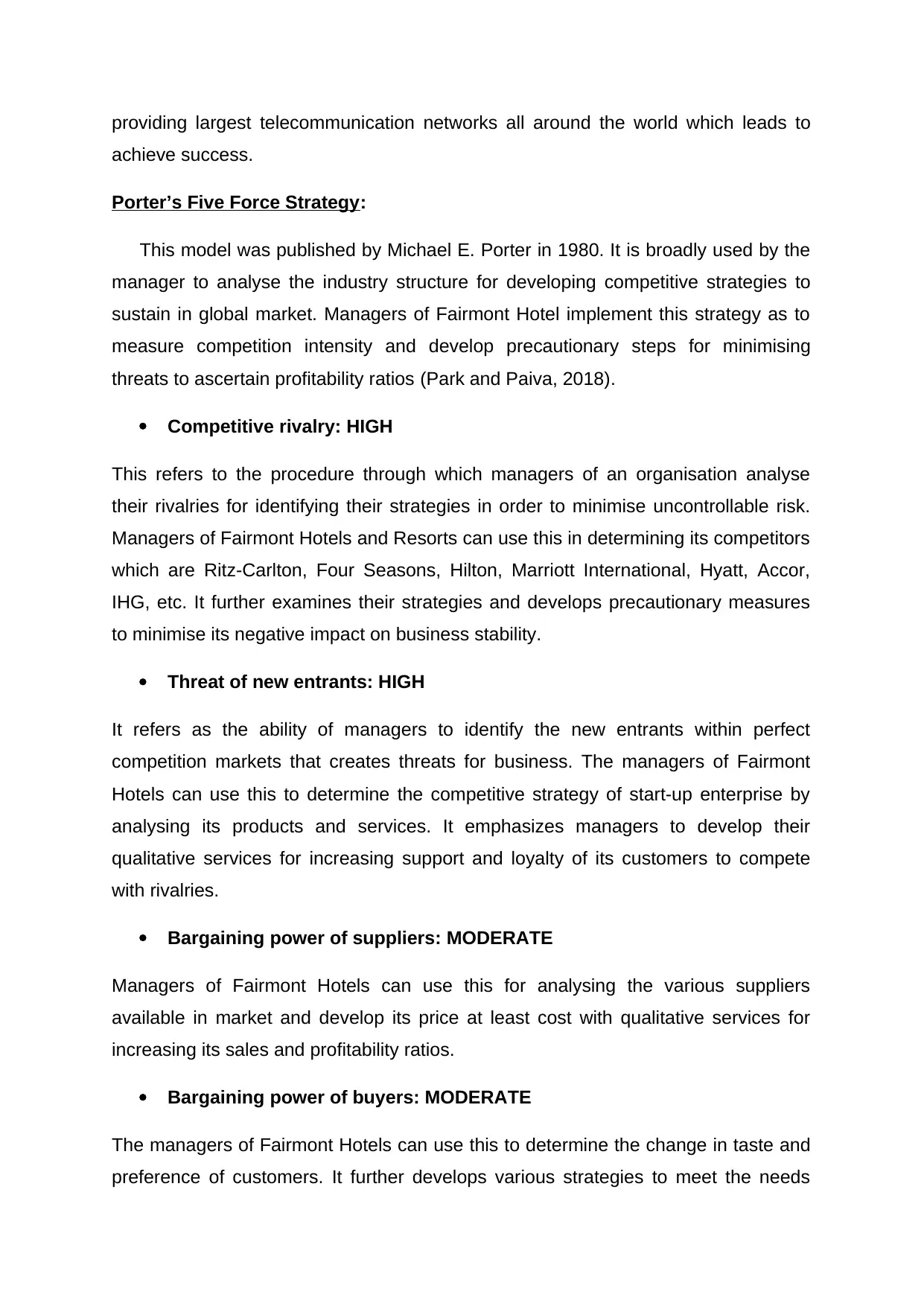
providing largest telecommunication networks all around the world which leads to
achieve success.
Porter’s Five Force Strategy:
This model was published by Michael E. Porter in 1980. It is broadly used by the
manager to analyse the industry structure for developing competitive strategies to
sustain in global market. Managers of Fairmont Hotel implement this strategy as to
measure competition intensity and develop precautionary steps for minimising
threats to ascertain profitability ratios (Park and Paiva, 2018).
Competitive rivalry: HIGH
This refers to the procedure through which managers of an organisation analyse
their rivalries for identifying their strategies in order to minimise uncontrollable risk.
Managers of Fairmont Hotels and Resorts can use this in determining its competitors
which are Ritz-Carlton, Four Seasons, Hilton, Marriott International, Hyatt, Accor,
IHG, etc. It further examines their strategies and develops precautionary measures
to minimise its negative impact on business stability.
Threat of new entrants: HIGH
It refers as the ability of managers to identify the new entrants within perfect
competition markets that creates threats for business. The managers of Fairmont
Hotels can use this to determine the competitive strategy of start-up enterprise by
analysing its products and services. It emphasizes managers to develop their
qualitative services for increasing support and loyalty of its customers to compete
with rivalries.
Bargaining power of suppliers: MODERATE
Managers of Fairmont Hotels can use this for analysing the various suppliers
available in market and develop its price at least cost with qualitative services for
increasing its sales and profitability ratios.
Bargaining power of buyers: MODERATE
The managers of Fairmont Hotels can use this to determine the change in taste and
preference of customers. It further develops various strategies to meet the needs
achieve success.
Porter’s Five Force Strategy:
This model was published by Michael E. Porter in 1980. It is broadly used by the
manager to analyse the industry structure for developing competitive strategies to
sustain in global market. Managers of Fairmont Hotel implement this strategy as to
measure competition intensity and develop precautionary steps for minimising
threats to ascertain profitability ratios (Park and Paiva, 2018).
Competitive rivalry: HIGH
This refers to the procedure through which managers of an organisation analyse
their rivalries for identifying their strategies in order to minimise uncontrollable risk.
Managers of Fairmont Hotels and Resorts can use this in determining its competitors
which are Ritz-Carlton, Four Seasons, Hilton, Marriott International, Hyatt, Accor,
IHG, etc. It further examines their strategies and develops precautionary measures
to minimise its negative impact on business stability.
Threat of new entrants: HIGH
It refers as the ability of managers to identify the new entrants within perfect
competition markets that creates threats for business. The managers of Fairmont
Hotels can use this to determine the competitive strategy of start-up enterprise by
analysing its products and services. It emphasizes managers to develop their
qualitative services for increasing support and loyalty of its customers to compete
with rivalries.
Bargaining power of suppliers: MODERATE
Managers of Fairmont Hotels can use this for analysing the various suppliers
available in market and develop its price at least cost with qualitative services for
increasing its sales and profitability ratios.
Bargaining power of buyers: MODERATE
The managers of Fairmont Hotels can use this to determine the change in taste and
preference of customers. It further develops various strategies to meet the needs
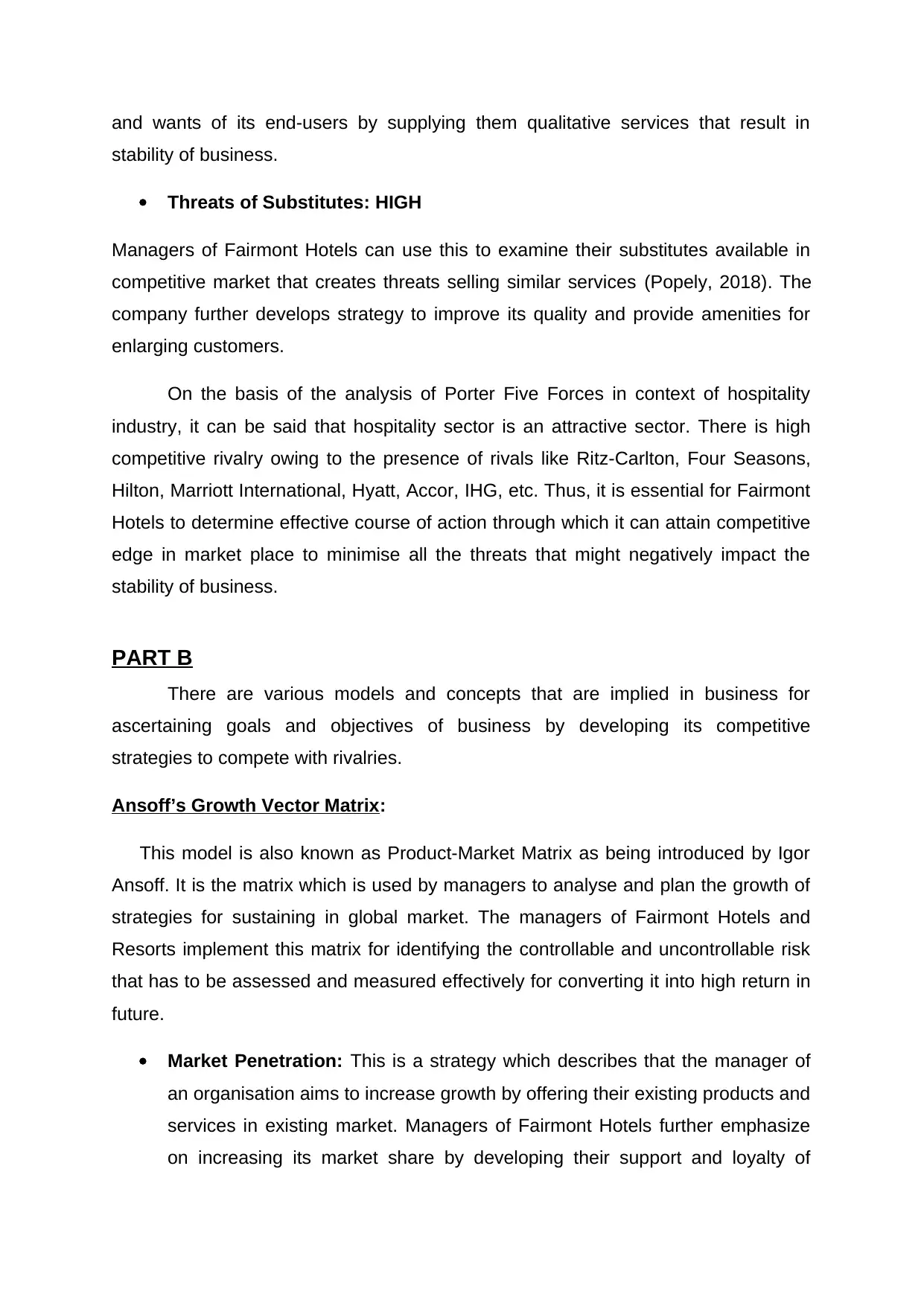
and wants of its end-users by supplying them qualitative services that result in
stability of business.
Threats of Substitutes: HIGH
Managers of Fairmont Hotels can use this to examine their substitutes available in
competitive market that creates threats selling similar services (Popely, 2018). The
company further develops strategy to improve its quality and provide amenities for
enlarging customers.
On the basis of the analysis of Porter Five Forces in context of hospitality
industry, it can be said that hospitality sector is an attractive sector. There is high
competitive rivalry owing to the presence of rivals like Ritz-Carlton, Four Seasons,
Hilton, Marriott International, Hyatt, Accor, IHG, etc. Thus, it is essential for Fairmont
Hotels to determine effective course of action through which it can attain competitive
edge in market place to minimise all the threats that might negatively impact the
stability of business.
PART B
There are various models and concepts that are implied in business for
ascertaining goals and objectives of business by developing its competitive
strategies to compete with rivalries.
Ansoff’s Growth Vector Matrix:
This model is also known as Product-Market Matrix as being introduced by Igor
Ansoff. It is the matrix which is used by managers to analyse and plan the growth of
strategies for sustaining in global market. The managers of Fairmont Hotels and
Resorts implement this matrix for identifying the controllable and uncontrollable risk
that has to be assessed and measured effectively for converting it into high return in
future.
Market Penetration: This is a strategy which describes that the manager of
an organisation aims to increase growth by offering their existing products and
services in existing market. Managers of Fairmont Hotels further emphasize
on increasing its market share by developing their support and loyalty of
stability of business.
Threats of Substitutes: HIGH
Managers of Fairmont Hotels can use this to examine their substitutes available in
competitive market that creates threats selling similar services (Popely, 2018). The
company further develops strategy to improve its quality and provide amenities for
enlarging customers.
On the basis of the analysis of Porter Five Forces in context of hospitality
industry, it can be said that hospitality sector is an attractive sector. There is high
competitive rivalry owing to the presence of rivals like Ritz-Carlton, Four Seasons,
Hilton, Marriott International, Hyatt, Accor, IHG, etc. Thus, it is essential for Fairmont
Hotels to determine effective course of action through which it can attain competitive
edge in market place to minimise all the threats that might negatively impact the
stability of business.
PART B
There are various models and concepts that are implied in business for
ascertaining goals and objectives of business by developing its competitive
strategies to compete with rivalries.
Ansoff’s Growth Vector Matrix:
This model is also known as Product-Market Matrix as being introduced by Igor
Ansoff. It is the matrix which is used by managers to analyse and plan the growth of
strategies for sustaining in global market. The managers of Fairmont Hotels and
Resorts implement this matrix for identifying the controllable and uncontrollable risk
that has to be assessed and measured effectively for converting it into high return in
future.
Market Penetration: This is a strategy which describes that the manager of
an organisation aims to increase growth by offering their existing products and
services in existing market. Managers of Fairmont Hotels further emphasize
on increasing its market share by developing their support and loyalty of
Secure Best Marks with AI Grader
Need help grading? Try our AI Grader for instant feedback on your assignments.

existing customers through supplying them qualitative services (Turban,
Pollard and Wood, 2018).
Market Development: It is the process through which manager focus on
expanding business to various locations for increasing brand awareness and
positioning. The managers of Fairmont Hotels segment their target market
into small group in accordance with their culture, demographic conditions, etc.
This results in meeting the requirements of customers by providing them
various facilities to fulfil their desires with high level of satisfaction.
Product Development: This refers as the ability of managers to create new
differentiated products or services that attracts large number of customers to
survive their livelihood effectively. Managers of Fairmont Hotel invest on
research and development programs by analysing the change in needs and
wants of customer to develop variety of services. This aims to develop
specialised products and services at existing market for enlarging customers.
Diversification: It is the process through which managers tries to increase
market share by introducing new products at new market. This is most risky
strategy adopted by directors of an organisation for both product and market
development. Managers of Fairmont Hotel can use this strategy as to bring
some change by entering in new market with their specialised products that
increase competitive strategies to sustain in global market.
From the above prescribed Ansoff’s Growth Vector Matrix, managers of
Fairmont Hotels and Resorts emphasize on market development as they aims to
expand their business at various locations for increasing brand awareness and
positioning.
Strategic Management Plan
Features Explanation
Vision The vision of Fairmont Hotels and Resorts is to provide
experiences that are authentically local with its supreme presence
and truly engaged services for customers.
Mission The mission of Fairmont Hotels and Resorts is to turn moments
into memories of guests with their warm and engaging employee
relations and delivering qualitative services.
Pollard and Wood, 2018).
Market Development: It is the process through which manager focus on
expanding business to various locations for increasing brand awareness and
positioning. The managers of Fairmont Hotels segment their target market
into small group in accordance with their culture, demographic conditions, etc.
This results in meeting the requirements of customers by providing them
various facilities to fulfil their desires with high level of satisfaction.
Product Development: This refers as the ability of managers to create new
differentiated products or services that attracts large number of customers to
survive their livelihood effectively. Managers of Fairmont Hotel invest on
research and development programs by analysing the change in needs and
wants of customer to develop variety of services. This aims to develop
specialised products and services at existing market for enlarging customers.
Diversification: It is the process through which managers tries to increase
market share by introducing new products at new market. This is most risky
strategy adopted by directors of an organisation for both product and market
development. Managers of Fairmont Hotel can use this strategy as to bring
some change by entering in new market with their specialised products that
increase competitive strategies to sustain in global market.
From the above prescribed Ansoff’s Growth Vector Matrix, managers of
Fairmont Hotels and Resorts emphasize on market development as they aims to
expand their business at various locations for increasing brand awareness and
positioning.
Strategic Management Plan
Features Explanation
Vision The vision of Fairmont Hotels and Resorts is to provide
experiences that are authentically local with its supreme presence
and truly engaged services for customers.
Mission The mission of Fairmont Hotels and Resorts is to turn moments
into memories of guests with their warm and engaging employee
relations and delivering qualitative services.
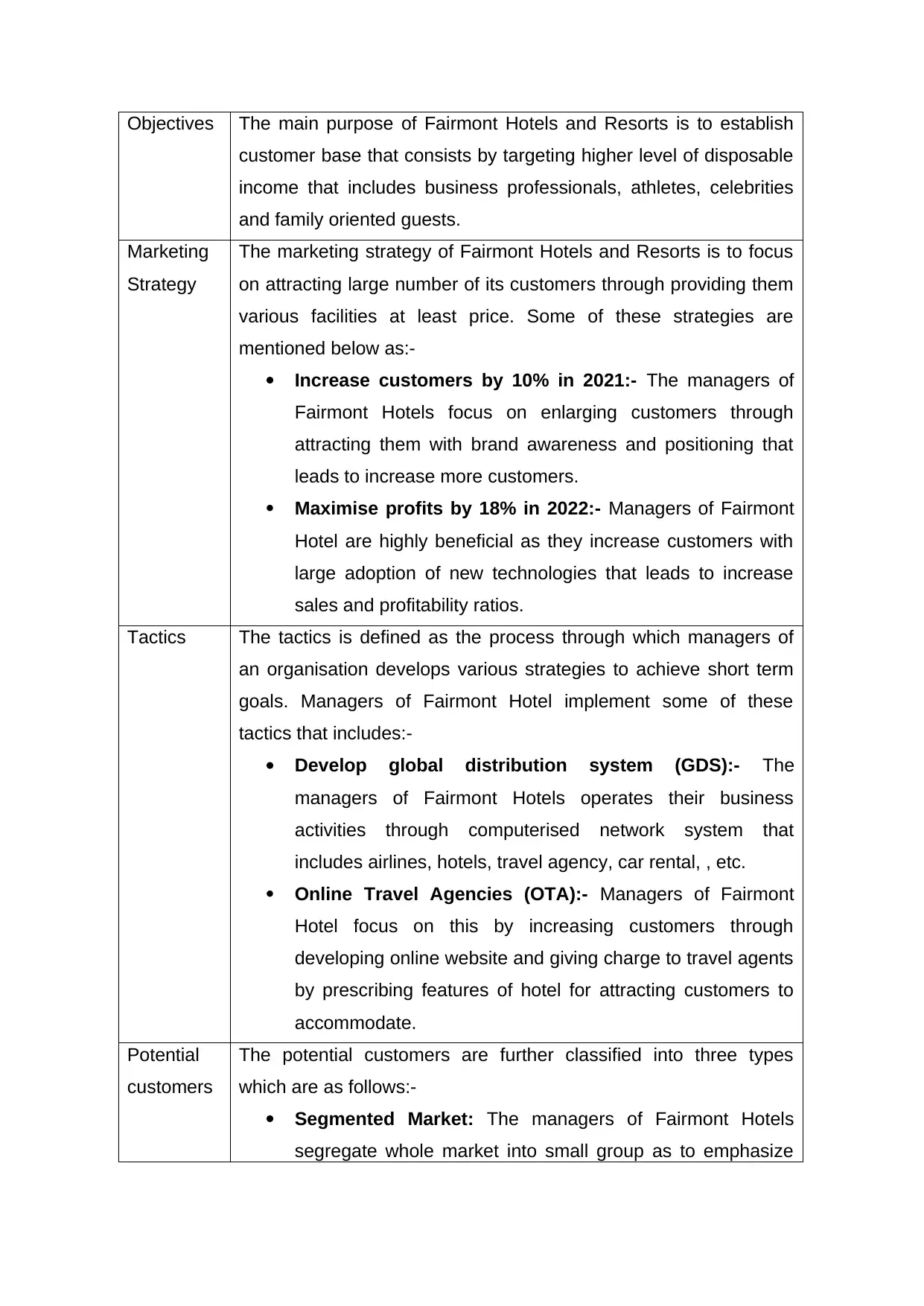
Objectives The main purpose of Fairmont Hotels and Resorts is to establish
customer base that consists by targeting higher level of disposable
income that includes business professionals, athletes, celebrities
and family oriented guests.
Marketing
Strategy
The marketing strategy of Fairmont Hotels and Resorts is to focus
on attracting large number of its customers through providing them
various facilities at least price. Some of these strategies are
mentioned below as:-
Increase customers by 10% in 2021:- The managers of
Fairmont Hotels focus on enlarging customers through
attracting them with brand awareness and positioning that
leads to increase more customers.
Maximise profits by 18% in 2022:- Managers of Fairmont
Hotel are highly beneficial as they increase customers with
large adoption of new technologies that leads to increase
sales and profitability ratios.
Tactics The tactics is defined as the process through which managers of
an organisation develops various strategies to achieve short term
goals. Managers of Fairmont Hotel implement some of these
tactics that includes:-
Develop global distribution system (GDS):- The
managers of Fairmont Hotels operates their business
activities through computerised network system that
includes airlines, hotels, travel agency, car rental, , etc.
Online Travel Agencies (OTA):- Managers of Fairmont
Hotel focus on this by increasing customers through
developing online website and giving charge to travel agents
by prescribing features of hotel for attracting customers to
accommodate.
Potential
customers
The potential customers are further classified into three types
which are as follows:-
Segmented Market: The managers of Fairmont Hotels
segregate whole market into small group as to emphasize
customer base that consists by targeting higher level of disposable
income that includes business professionals, athletes, celebrities
and family oriented guests.
Marketing
Strategy
The marketing strategy of Fairmont Hotels and Resorts is to focus
on attracting large number of its customers through providing them
various facilities at least price. Some of these strategies are
mentioned below as:-
Increase customers by 10% in 2021:- The managers of
Fairmont Hotels focus on enlarging customers through
attracting them with brand awareness and positioning that
leads to increase more customers.
Maximise profits by 18% in 2022:- Managers of Fairmont
Hotel are highly beneficial as they increase customers with
large adoption of new technologies that leads to increase
sales and profitability ratios.
Tactics The tactics is defined as the process through which managers of
an organisation develops various strategies to achieve short term
goals. Managers of Fairmont Hotel implement some of these
tactics that includes:-
Develop global distribution system (GDS):- The
managers of Fairmont Hotels operates their business
activities through computerised network system that
includes airlines, hotels, travel agency, car rental, , etc.
Online Travel Agencies (OTA):- Managers of Fairmont
Hotel focus on this by increasing customers through
developing online website and giving charge to travel agents
by prescribing features of hotel for attracting customers to
accommodate.
Potential
customers
The potential customers are further classified into three types
which are as follows:-
Segmented Market: The managers of Fairmont Hotels
segregate whole market into small group as to emphasize
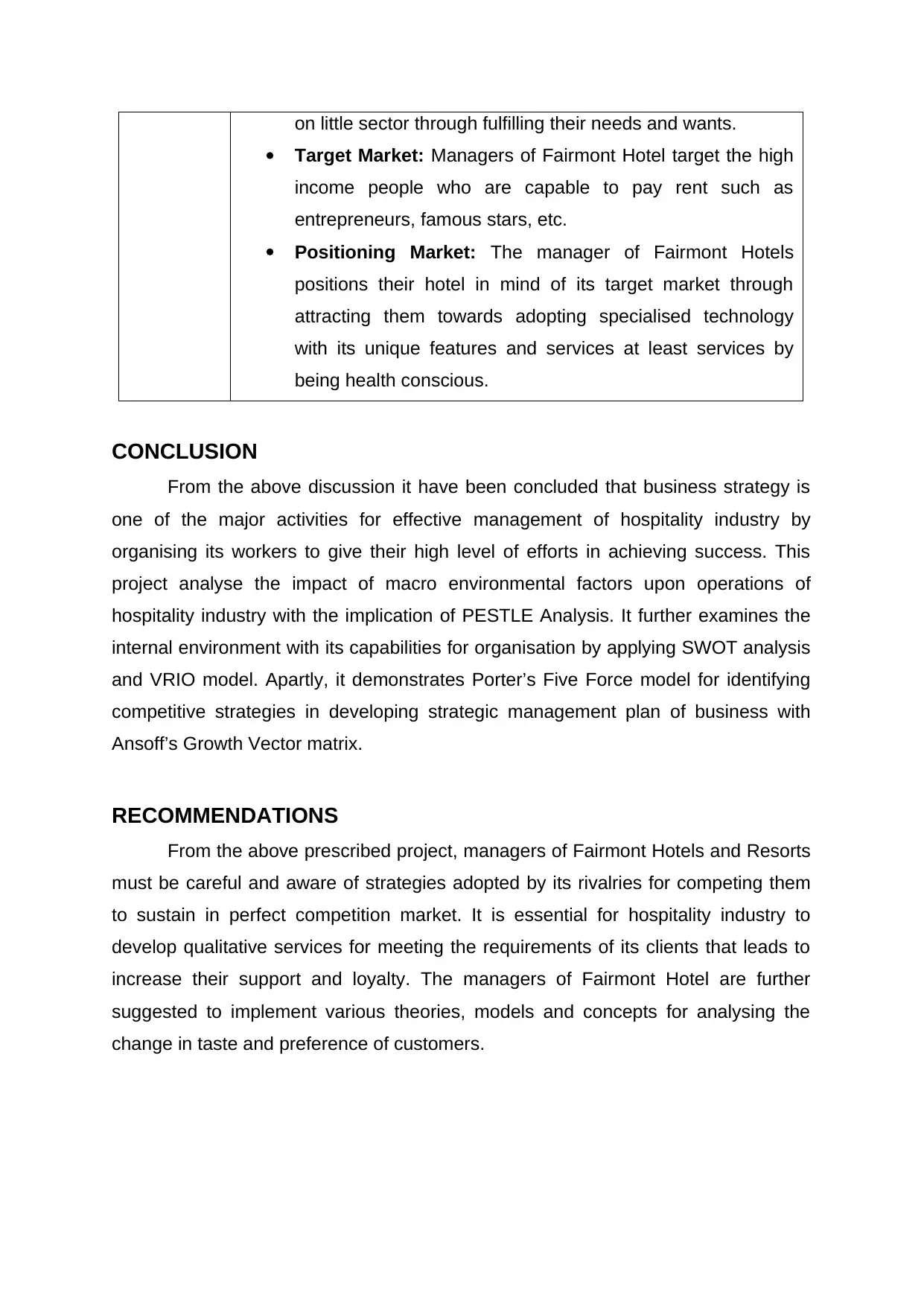
on little sector through fulfilling their needs and wants.
Target Market: Managers of Fairmont Hotel target the high
income people who are capable to pay rent such as
entrepreneurs, famous stars, etc.
Positioning Market: The manager of Fairmont Hotels
positions their hotel in mind of its target market through
attracting them towards adopting specialised technology
with its unique features and services at least services by
being health conscious.
CONCLUSION
From the above discussion it have been concluded that business strategy is
one of the major activities for effective management of hospitality industry by
organising its workers to give their high level of efforts in achieving success. This
project analyse the impact of macro environmental factors upon operations of
hospitality industry with the implication of PESTLE Analysis. It further examines the
internal environment with its capabilities for organisation by applying SWOT analysis
and VRIO model. Apartly, it demonstrates Porter’s Five Force model for identifying
competitive strategies in developing strategic management plan of business with
Ansoff’s Growth Vector matrix.
RECOMMENDATIONS
From the above prescribed project, managers of Fairmont Hotels and Resorts
must be careful and aware of strategies adopted by its rivalries for competing them
to sustain in perfect competition market. It is essential for hospitality industry to
develop qualitative services for meeting the requirements of its clients that leads to
increase their support and loyalty. The managers of Fairmont Hotel are further
suggested to implement various theories, models and concepts for analysing the
change in taste and preference of customers.
Target Market: Managers of Fairmont Hotel target the high
income people who are capable to pay rent such as
entrepreneurs, famous stars, etc.
Positioning Market: The manager of Fairmont Hotels
positions their hotel in mind of its target market through
attracting them towards adopting specialised technology
with its unique features and services at least services by
being health conscious.
CONCLUSION
From the above discussion it have been concluded that business strategy is
one of the major activities for effective management of hospitality industry by
organising its workers to give their high level of efforts in achieving success. This
project analyse the impact of macro environmental factors upon operations of
hospitality industry with the implication of PESTLE Analysis. It further examines the
internal environment with its capabilities for organisation by applying SWOT analysis
and VRIO model. Apartly, it demonstrates Porter’s Five Force model for identifying
competitive strategies in developing strategic management plan of business with
Ansoff’s Growth Vector matrix.
RECOMMENDATIONS
From the above prescribed project, managers of Fairmont Hotels and Resorts
must be careful and aware of strategies adopted by its rivalries for competing them
to sustain in perfect competition market. It is essential for hospitality industry to
develop qualitative services for meeting the requirements of its clients that leads to
increase their support and loyalty. The managers of Fairmont Hotel are further
suggested to implement various theories, models and concepts for analysing the
change in taste and preference of customers.
Paraphrase This Document
Need a fresh take? Get an instant paraphrase of this document with our AI Paraphraser
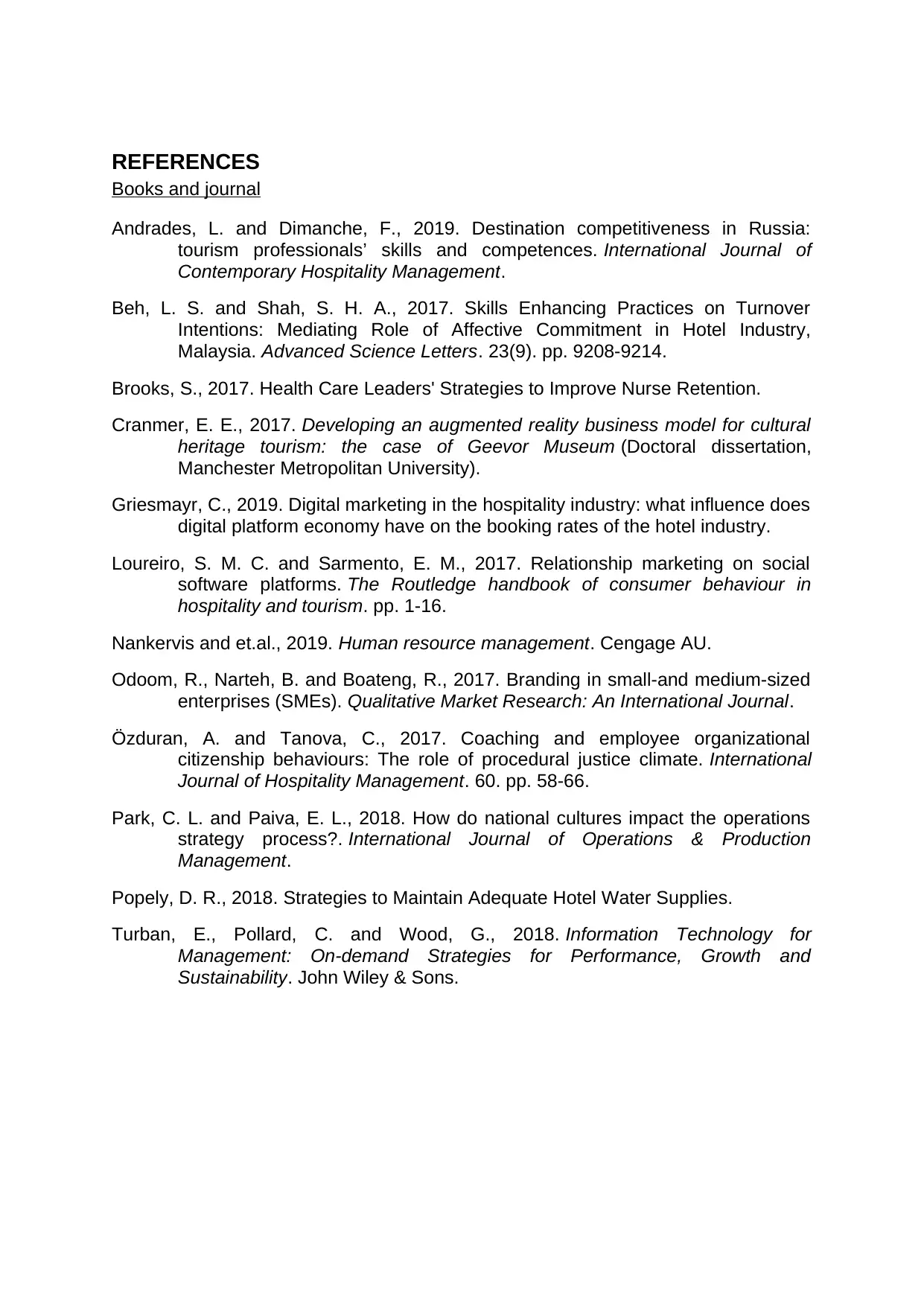
REFERENCES
Books and journal
Andrades, L. and Dimanche, F., 2019. Destination competitiveness in Russia:
tourism professionals’ skills and competences. International Journal of
Contemporary Hospitality Management.
Beh, L. S. and Shah, S. H. A., 2017. Skills Enhancing Practices on Turnover
Intentions: Mediating Role of Affective Commitment in Hotel Industry,
Malaysia. Advanced Science Letters. 23(9). pp. 9208-9214.
Brooks, S., 2017. Health Care Leaders' Strategies to Improve Nurse Retention.
Cranmer, E. E., 2017. Developing an augmented reality business model for cultural
heritage tourism: the case of Geevor Museum (Doctoral dissertation,
Manchester Metropolitan University).
Griesmayr, C., 2019. Digital marketing in the hospitality industry: what influence does
digital platform economy have on the booking rates of the hotel industry.
Loureiro, S. M. C. and Sarmento, E. M., 2017. Relationship marketing on social
software platforms. The Routledge handbook of consumer behaviour in
hospitality and tourism. pp. 1-16.
Nankervis and et.al., 2019. Human resource management. Cengage AU.
Odoom, R., Narteh, B. and Boateng, R., 2017. Branding in small-and medium-sized
enterprises (SMEs). Qualitative Market Research: An International Journal.
Özduran, A. and Tanova, C., 2017. Coaching and employee organizational
citizenship behaviours: The role of procedural justice climate. International
Journal of Hospitality Management. 60. pp. 58-66.
Park, C. L. and Paiva, E. L., 2018. How do national cultures impact the operations
strategy process?. International Journal of Operations & Production
Management.
Popely, D. R., 2018. Strategies to Maintain Adequate Hotel Water Supplies.
Turban, E., Pollard, C. and Wood, G., 2018. Information Technology for
Management: On-demand Strategies for Performance, Growth and
Sustainability. John Wiley & Sons.
Books and journal
Andrades, L. and Dimanche, F., 2019. Destination competitiveness in Russia:
tourism professionals’ skills and competences. International Journal of
Contemporary Hospitality Management.
Beh, L. S. and Shah, S. H. A., 2017. Skills Enhancing Practices on Turnover
Intentions: Mediating Role of Affective Commitment in Hotel Industry,
Malaysia. Advanced Science Letters. 23(9). pp. 9208-9214.
Brooks, S., 2017. Health Care Leaders' Strategies to Improve Nurse Retention.
Cranmer, E. E., 2017. Developing an augmented reality business model for cultural
heritage tourism: the case of Geevor Museum (Doctoral dissertation,
Manchester Metropolitan University).
Griesmayr, C., 2019. Digital marketing in the hospitality industry: what influence does
digital platform economy have on the booking rates of the hotel industry.
Loureiro, S. M. C. and Sarmento, E. M., 2017. Relationship marketing on social
software platforms. The Routledge handbook of consumer behaviour in
hospitality and tourism. pp. 1-16.
Nankervis and et.al., 2019. Human resource management. Cengage AU.
Odoom, R., Narteh, B. and Boateng, R., 2017. Branding in small-and medium-sized
enterprises (SMEs). Qualitative Market Research: An International Journal.
Özduran, A. and Tanova, C., 2017. Coaching and employee organizational
citizenship behaviours: The role of procedural justice climate. International
Journal of Hospitality Management. 60. pp. 58-66.
Park, C. L. and Paiva, E. L., 2018. How do national cultures impact the operations
strategy process?. International Journal of Operations & Production
Management.
Popely, D. R., 2018. Strategies to Maintain Adequate Hotel Water Supplies.
Turban, E., Pollard, C. and Wood, G., 2018. Information Technology for
Management: On-demand Strategies for Performance, Growth and
Sustainability. John Wiley & Sons.
1 out of 14
Related Documents
Your All-in-One AI-Powered Toolkit for Academic Success.
+13062052269
info@desklib.com
Available 24*7 on WhatsApp / Email
![[object Object]](/_next/static/media/star-bottom.7253800d.svg)
Unlock your academic potential
© 2024 | Zucol Services PVT LTD | All rights reserved.





